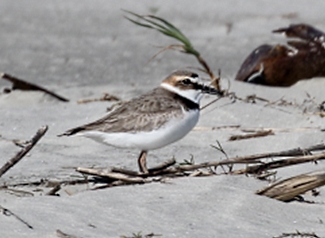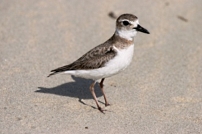Coastal Birds in South Carolina
Wilson's Plover

The Wilson's Plover is a medium sized, dark brown plover with a single neck band, pink legs, and a thick dark bill. Males have a dark black breast band while females are brown. These plovers often feed on fiddler crabs found in mudflats. Wilson's Plovers nest in open areas of sandy islands and inlets, often near dune edges or clumps of vegetation. They lay 3 eggs and the chicks are able to leave the nest within a few hours of hatching. Their nesting season is from March through July. To distract predators from its nest or chicks, Wilson's Plover parents will sometimes exhibit a "broken wing display." If you witness this behavior, you are too close, please back away from the area.

The Wilson's Plover has been extirpated from part of its historical breeding range. It once nested as far north as New Jersey, but has not been recorded in that state since 1955, and was last known to nest in Maryland in 1985. Its current northern most nesting range is Virginia where it is listed as Endangered in the state (Corbat & Bergstrom 2000). South Carolina has approximately 375 pairs of nesting Wilson's Plovers and it is listed as state threatened. The majority of Wilson's Plovers in South Carolina nest on public beaches, often near inlets. The major threats to this species are disturbance by humans at their nesting sites, predation of nests and chicks, and coastal development. SC DNR has participated in several studies of Wilson's Plovers that have been conducted in South Carolina.
- Dikun, K.A., 2008. Nest-site selection of Wilson's Plovers (Charadrius Wilsonia) in South Carolina. M.S. Thesis, Coastal Carolina University, Conway, South Carolina, USA.
- Sanders, F.J., Martin, M.C., Spinks, M.D., and N.J. Wallover. 2012. Abundance and distribution on Wilson's Plovers during the breeding season in South Carolina. The Chat 76:117-124.
- Zissner, E. 2013. Nest success and habitat choice of Wilson's Plovers in Tom Yawkey Wildlife Center Heritage Preserve, South Carolina. M.S. Thesis. Clemson University, Clemson, South Carolina, USA.
Literature Cited
Corbat, C.A., and P.W. Bergstrom. 2000. Wilson’s Plover (Charadrius wilsonia) In The Birds of North America, No.516 (A. Poole and F. Gill, eds.) The Birds of North America, Inc., Philadelphia, PA
